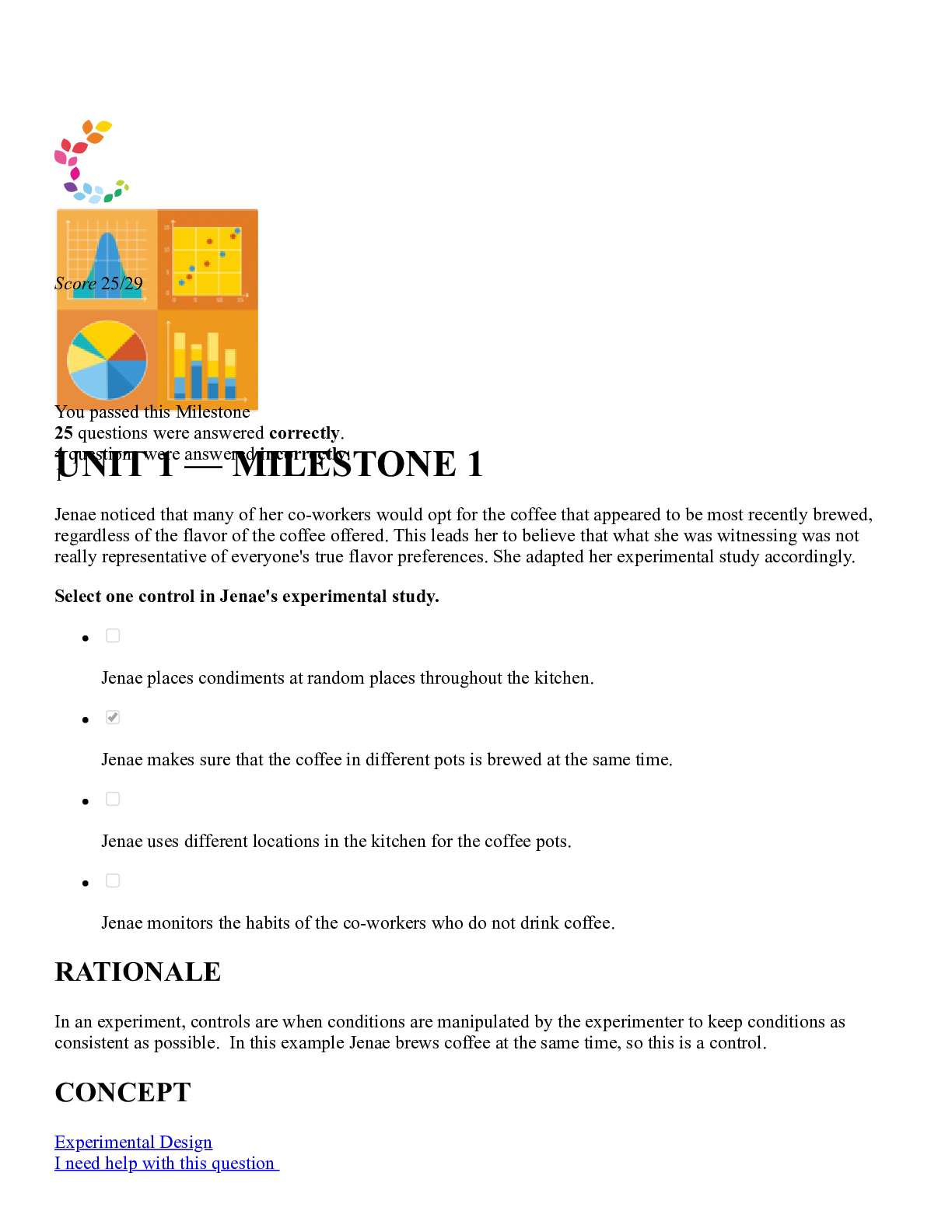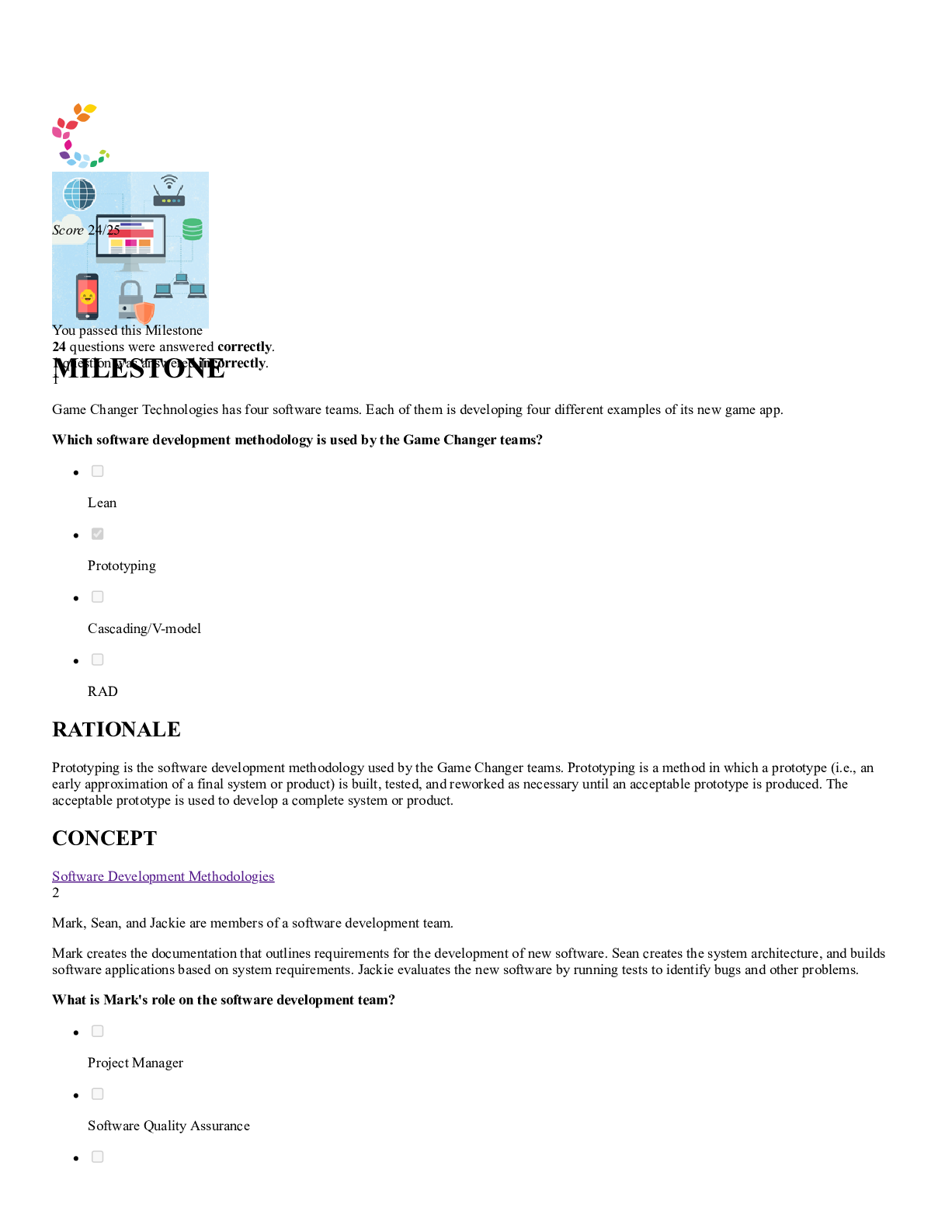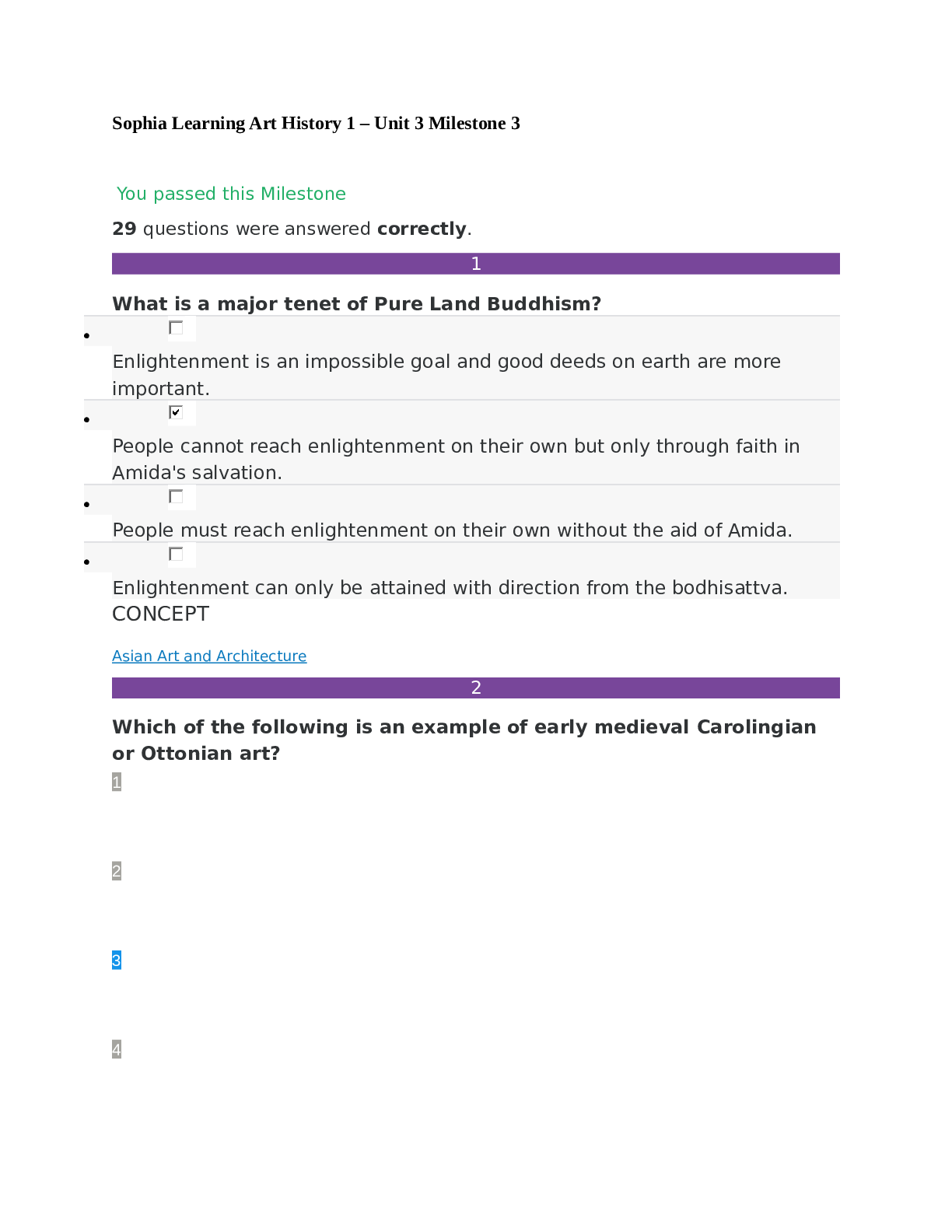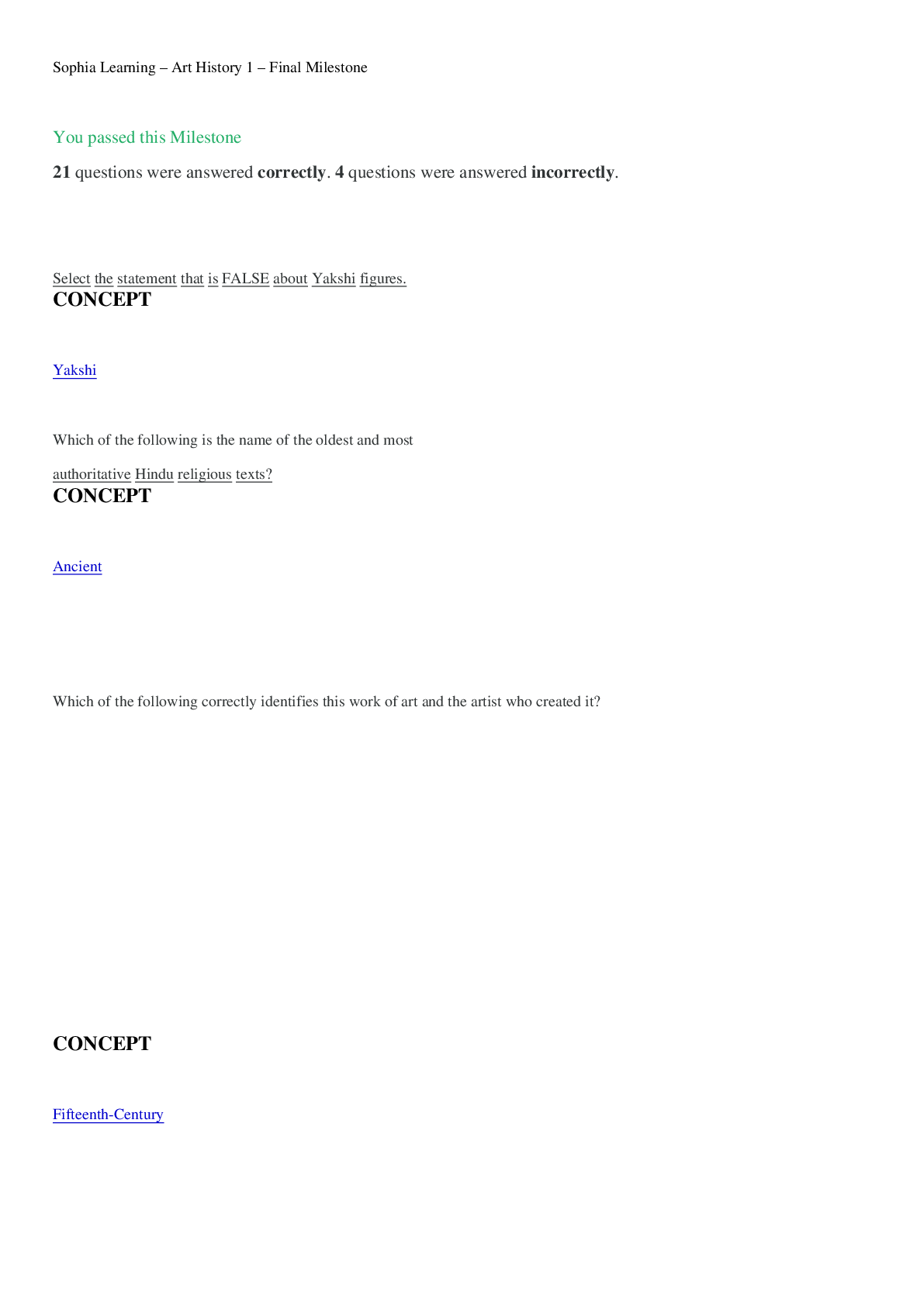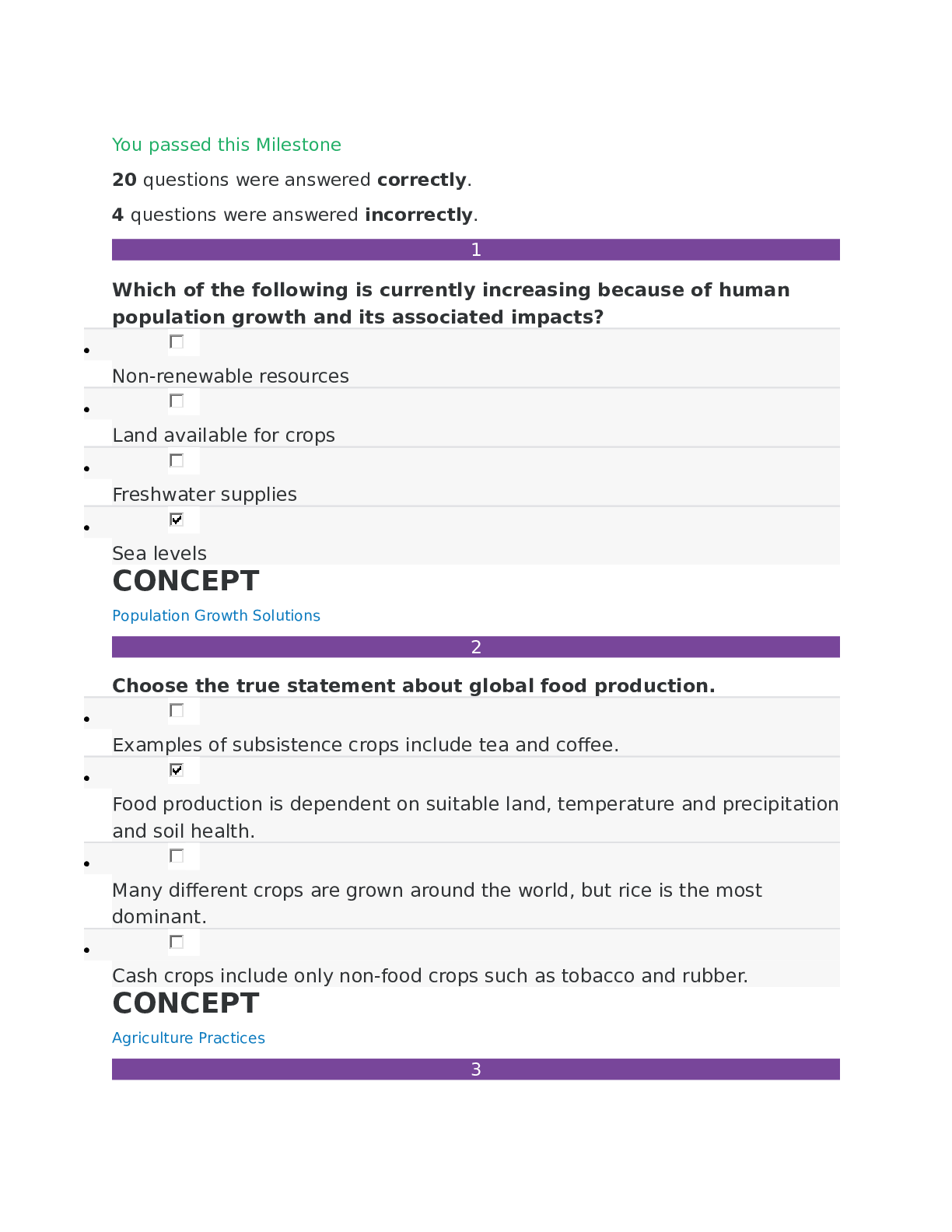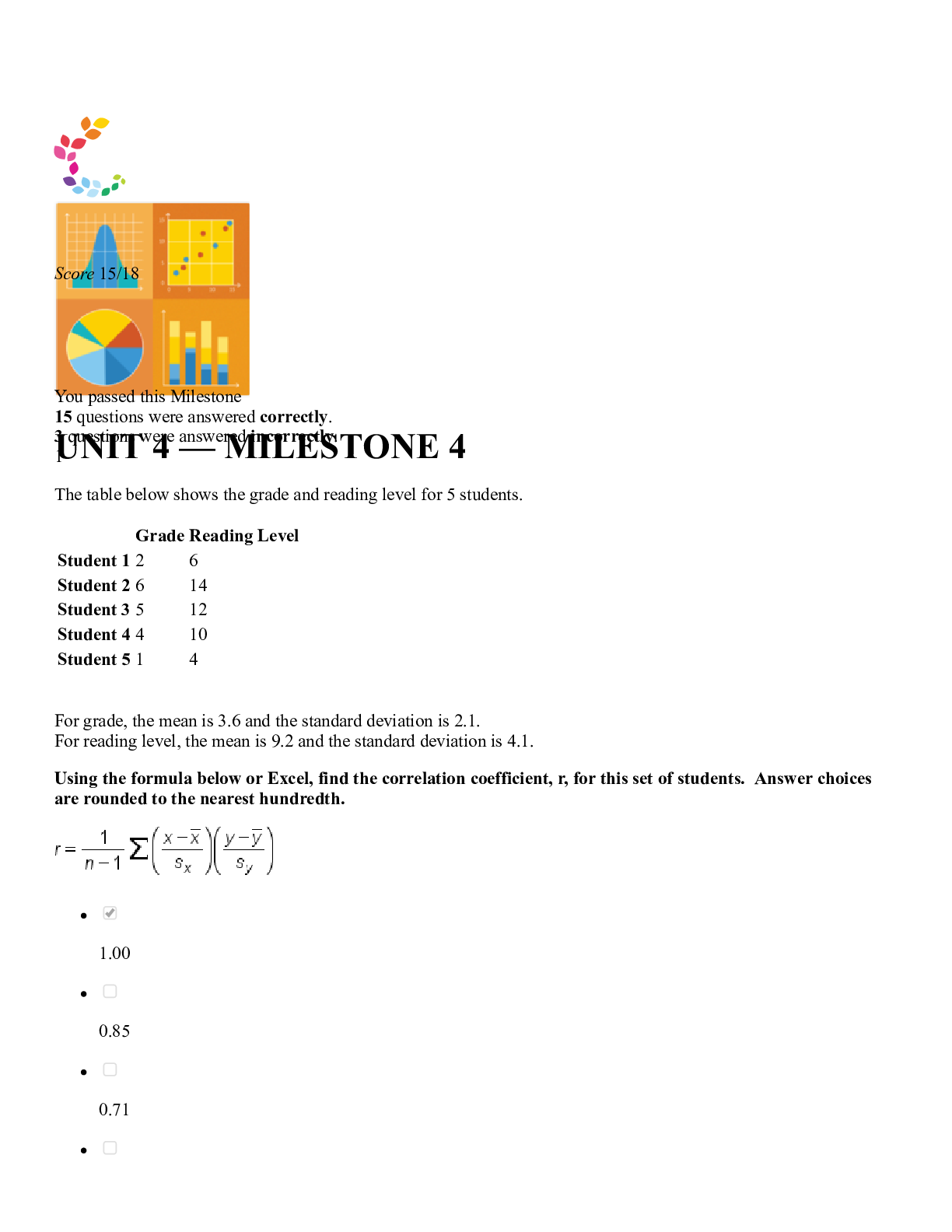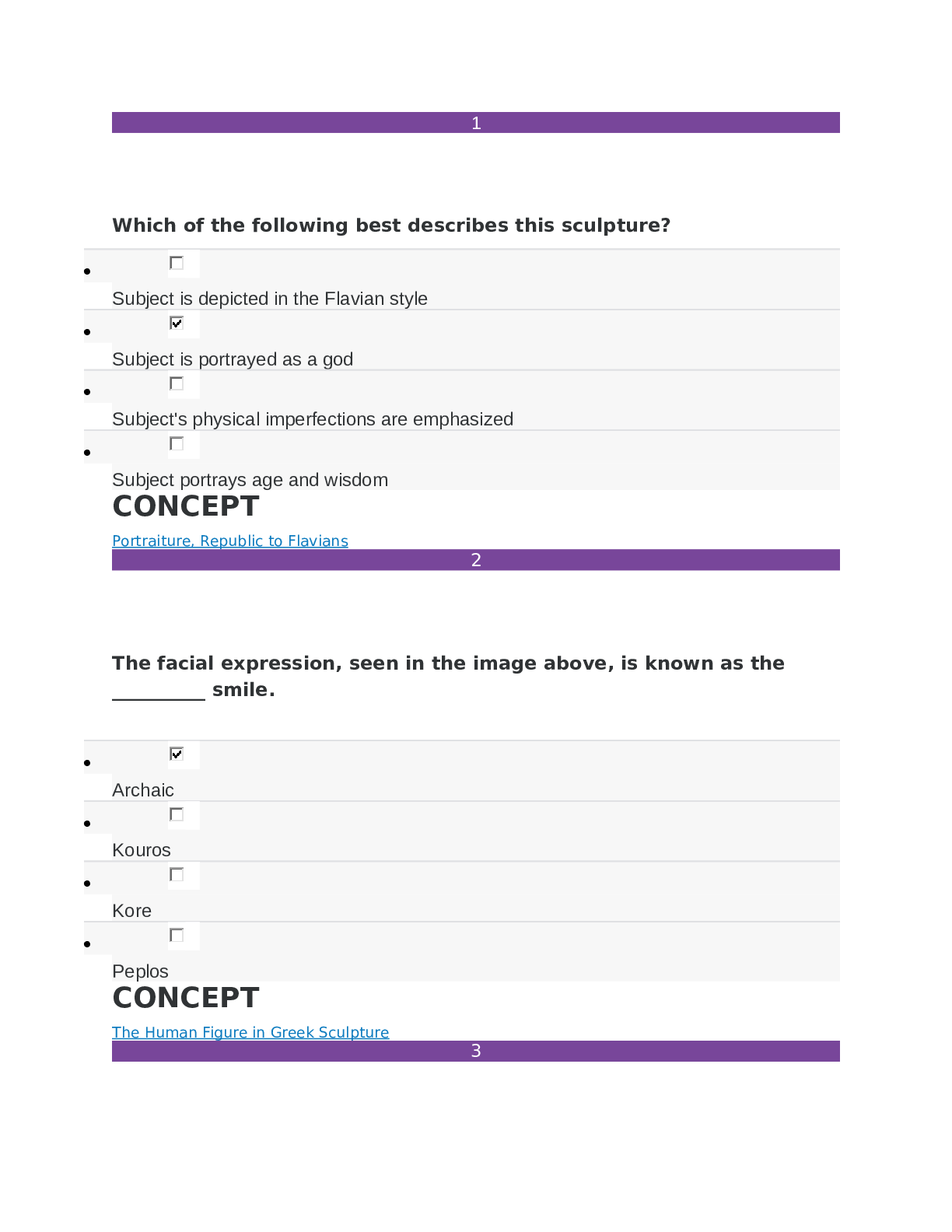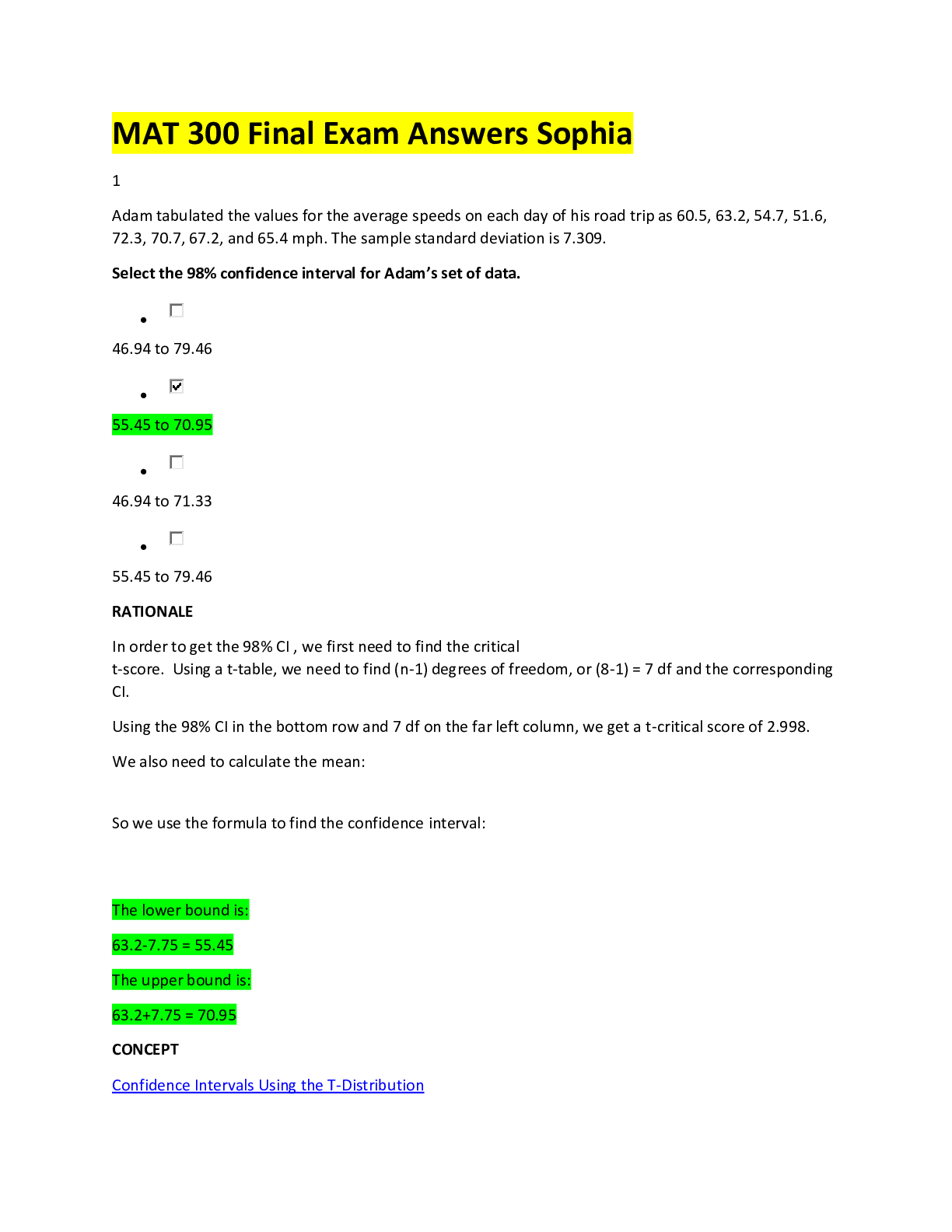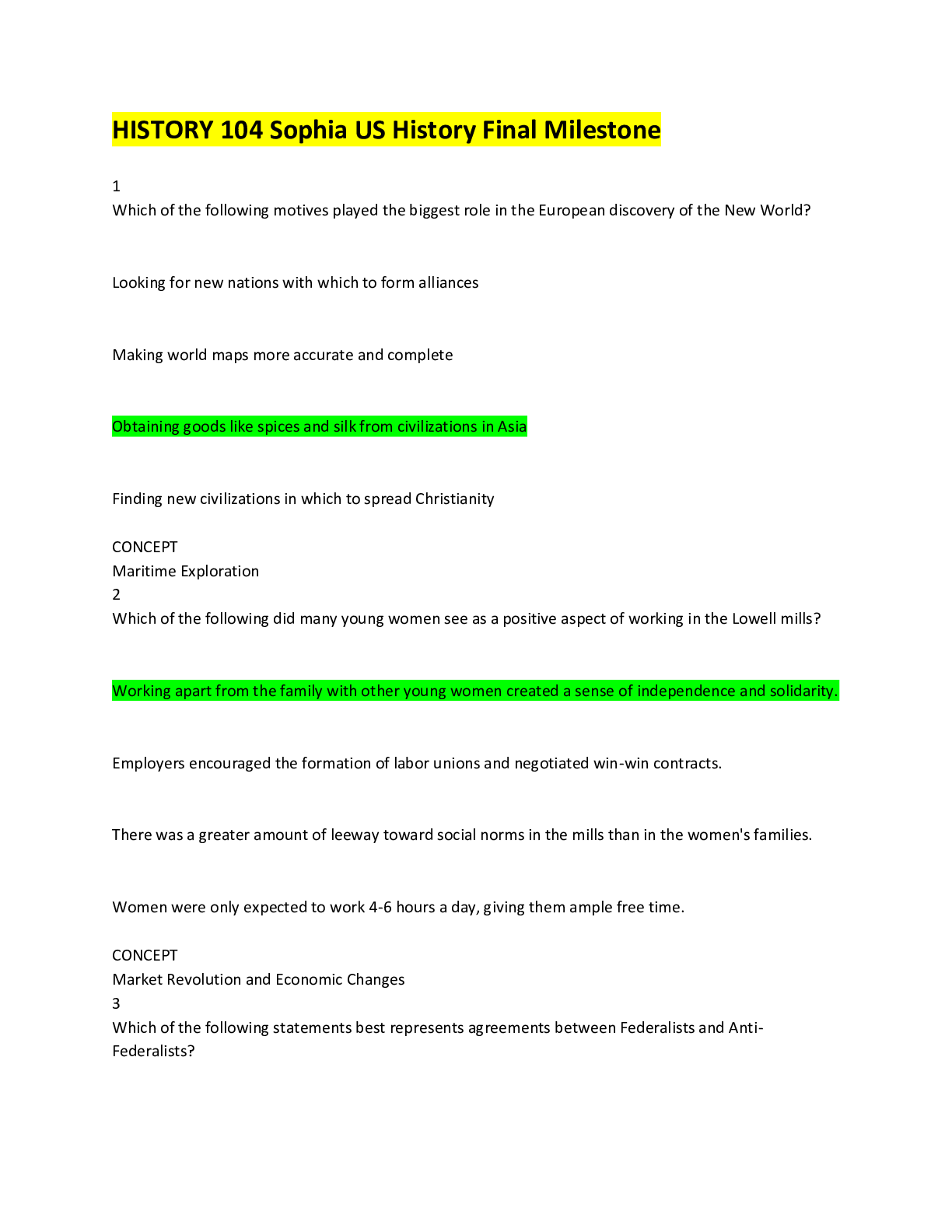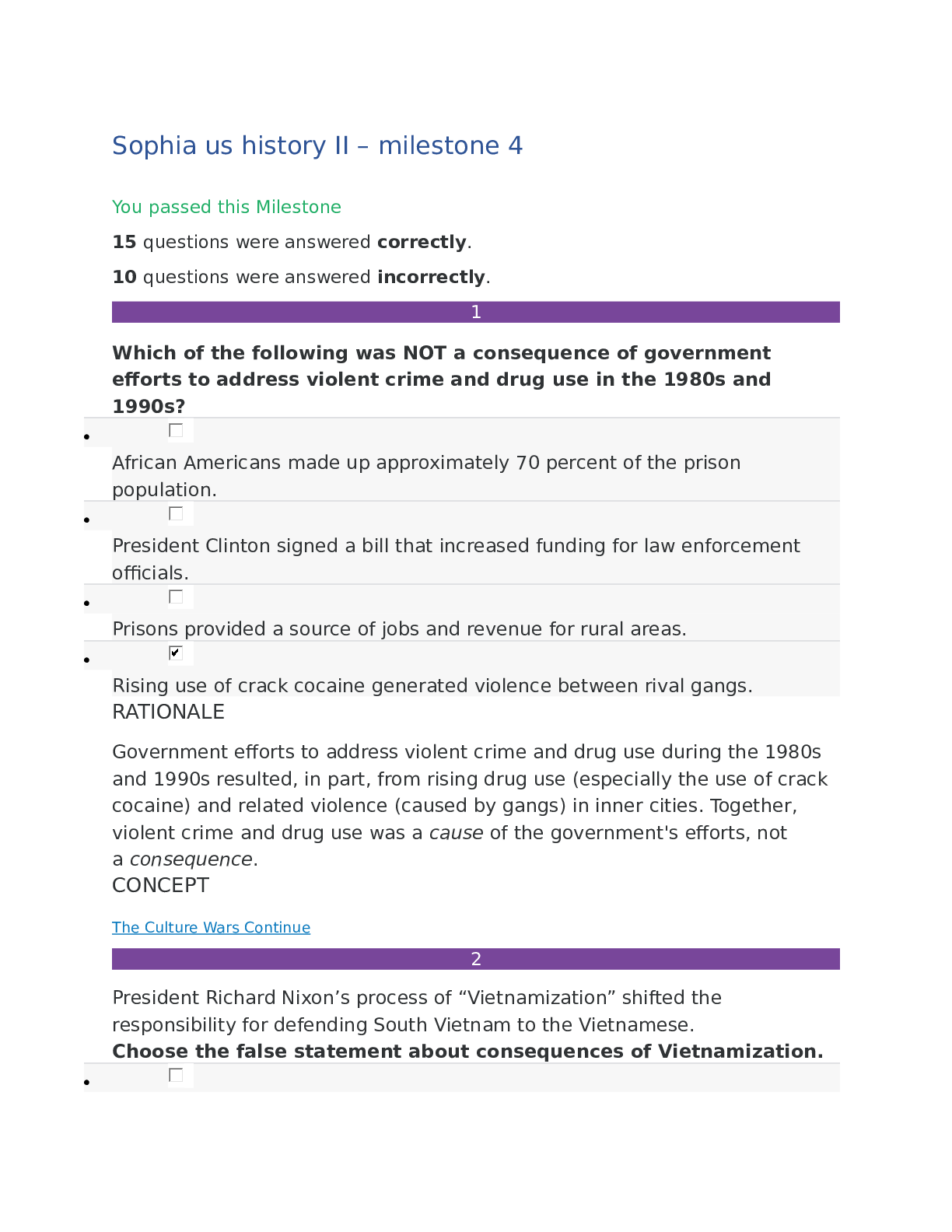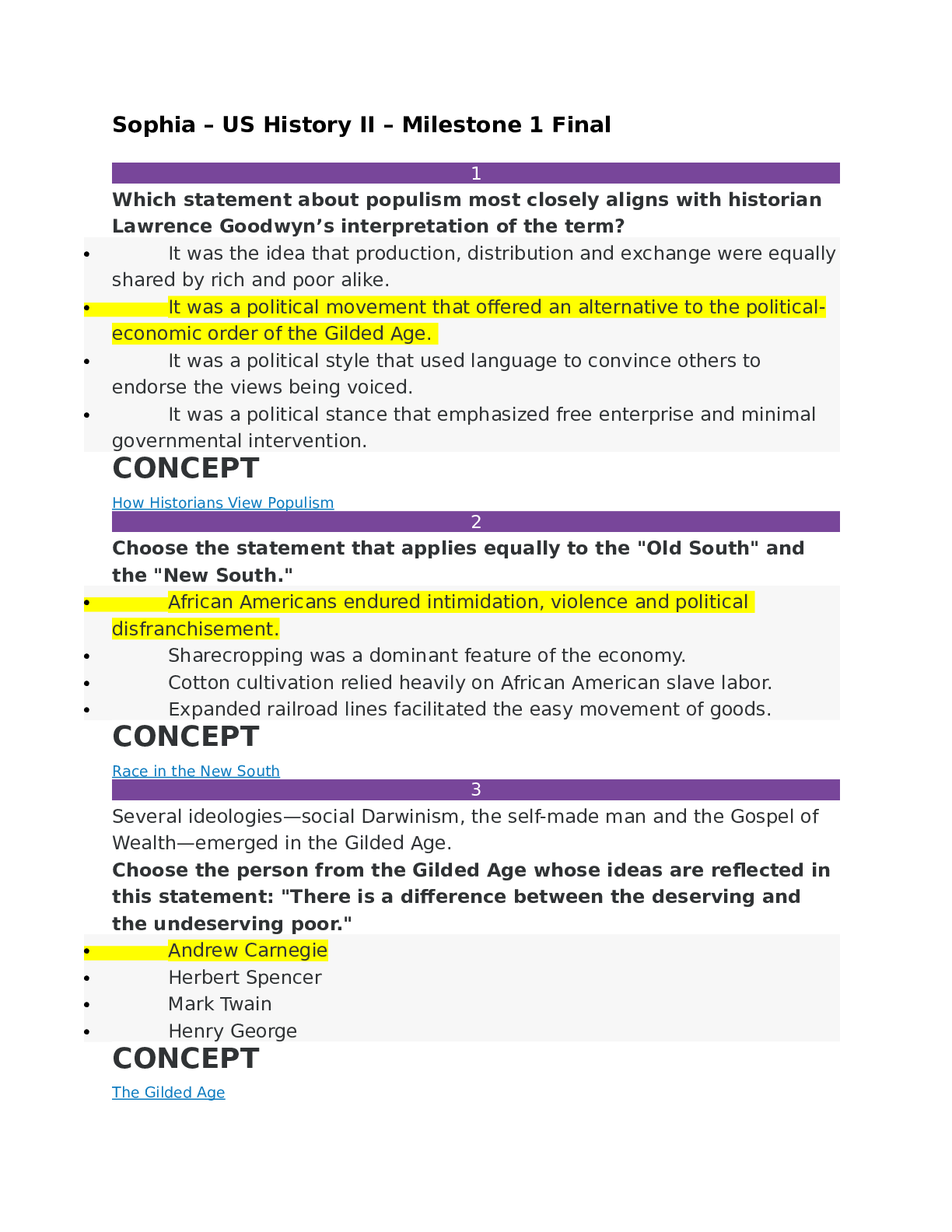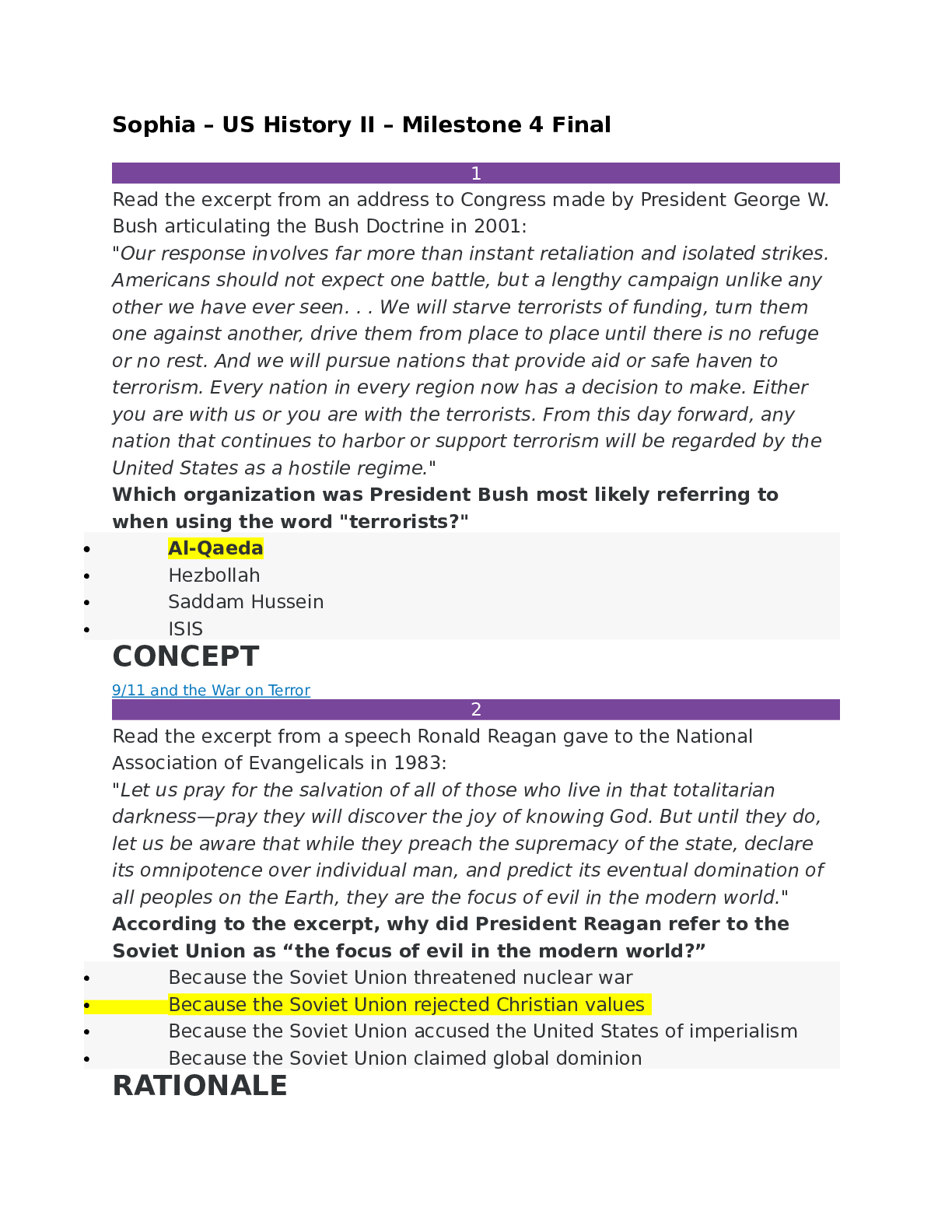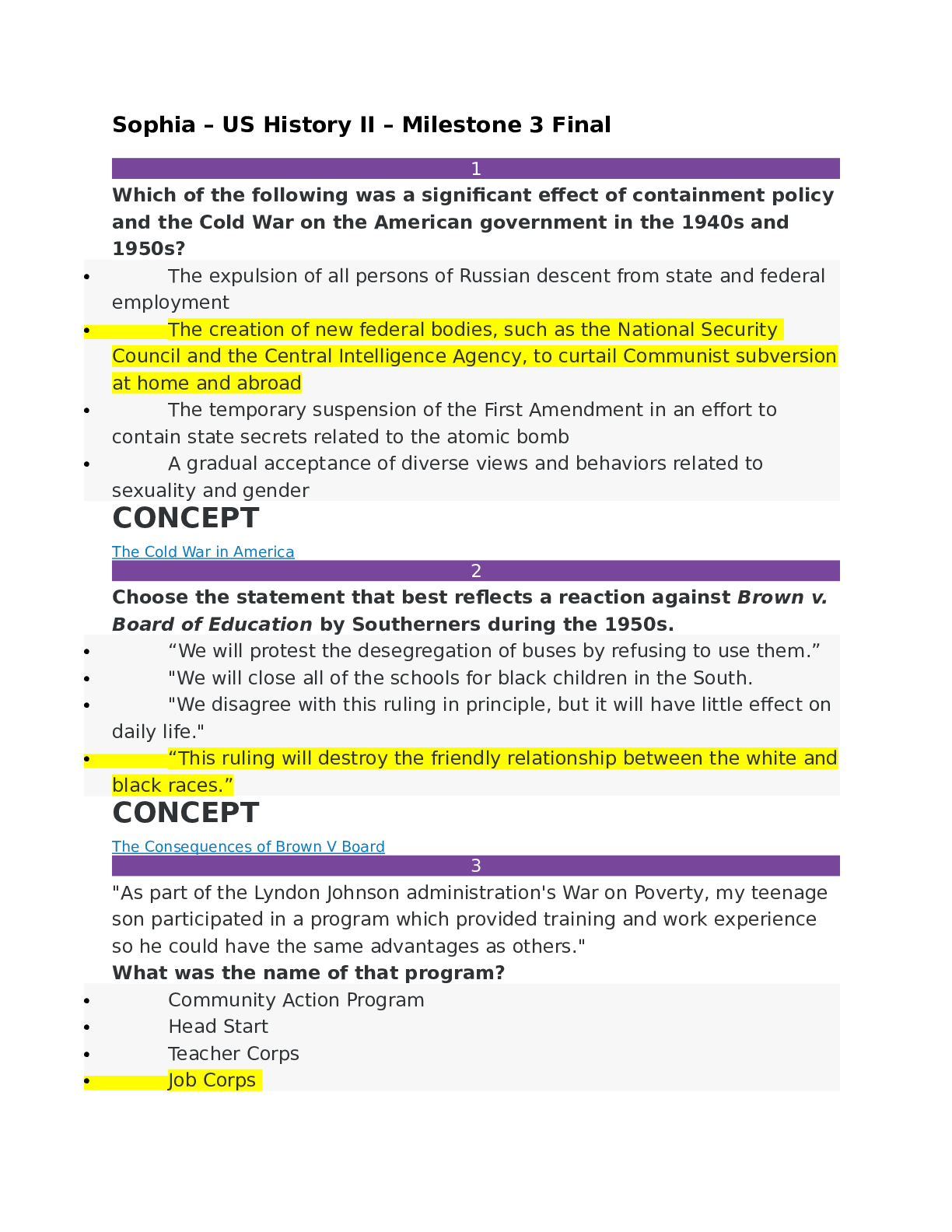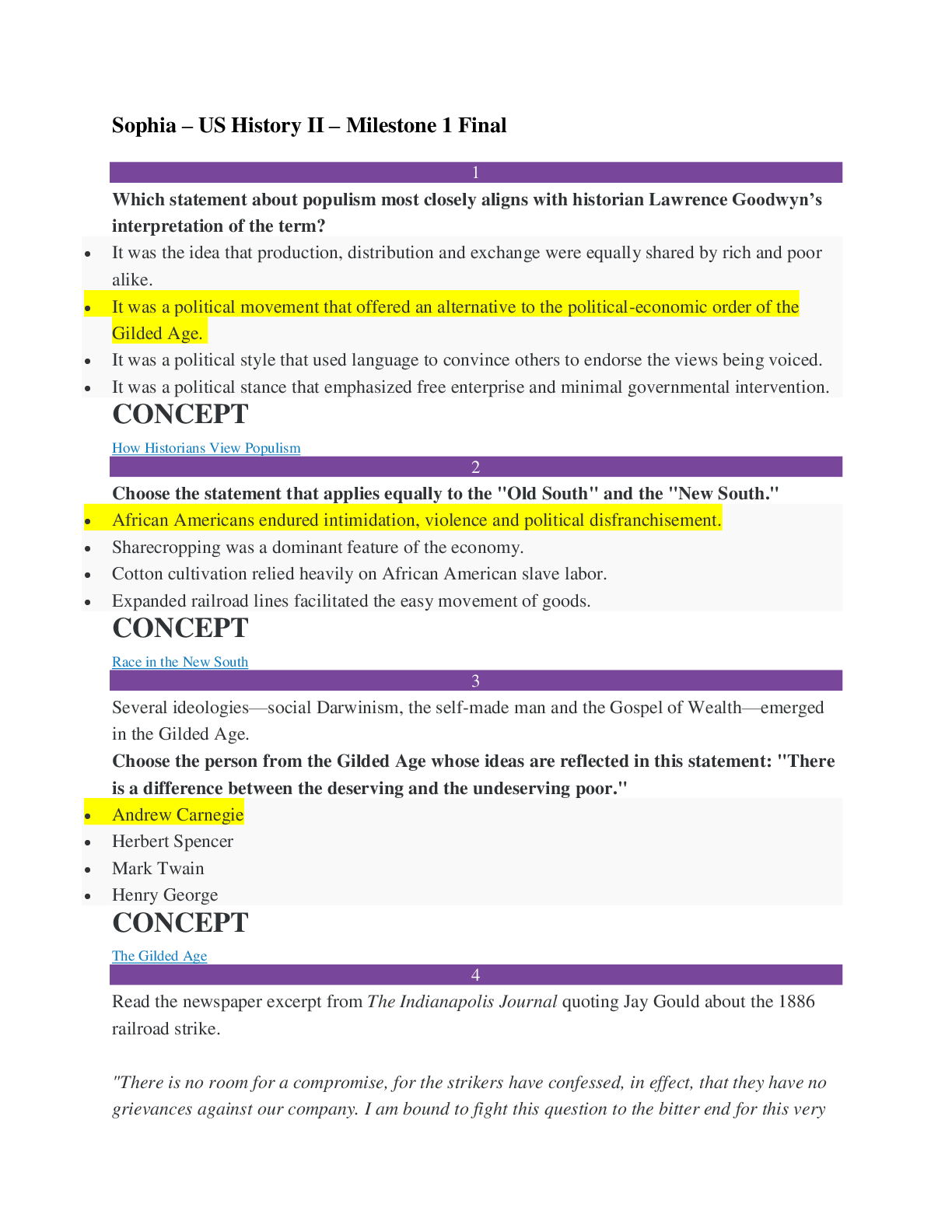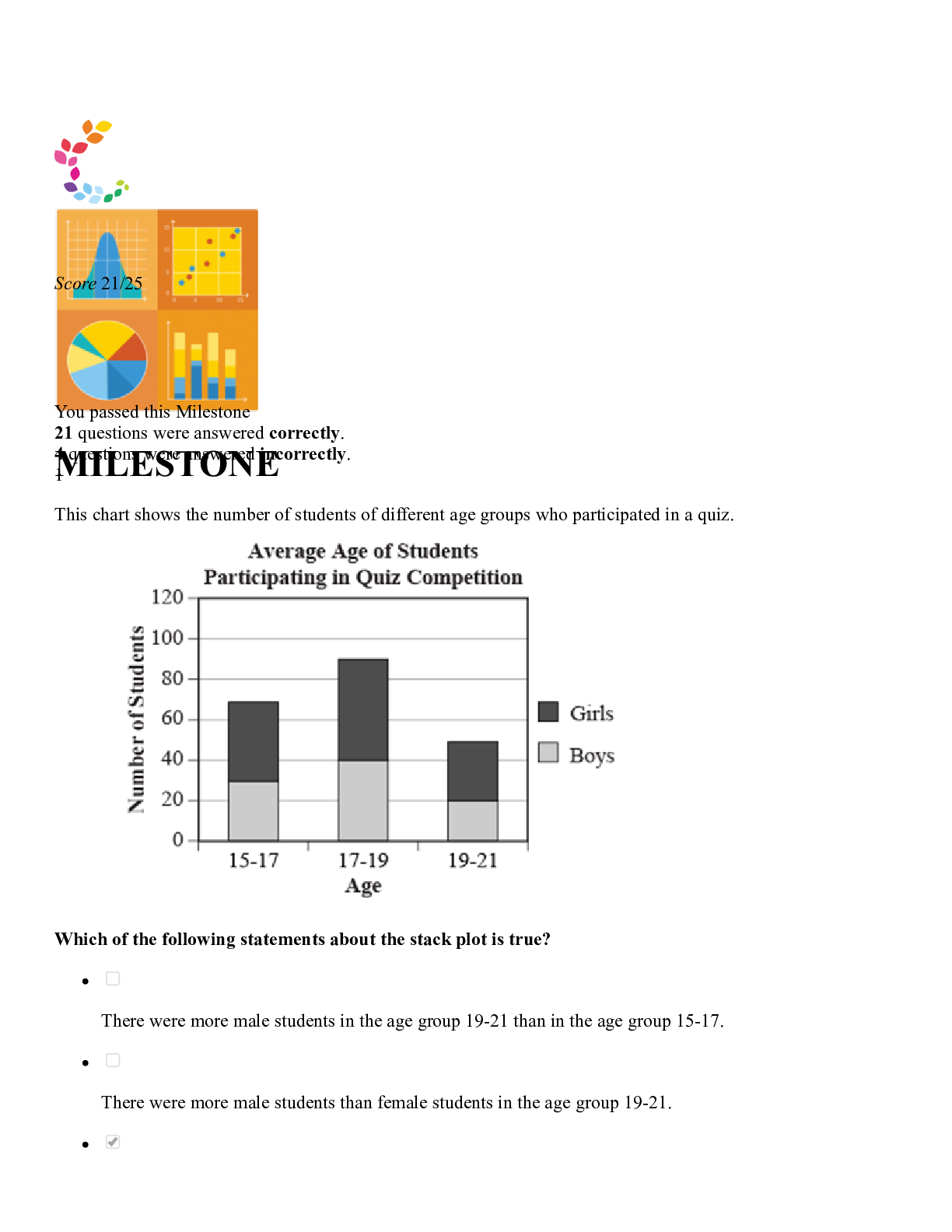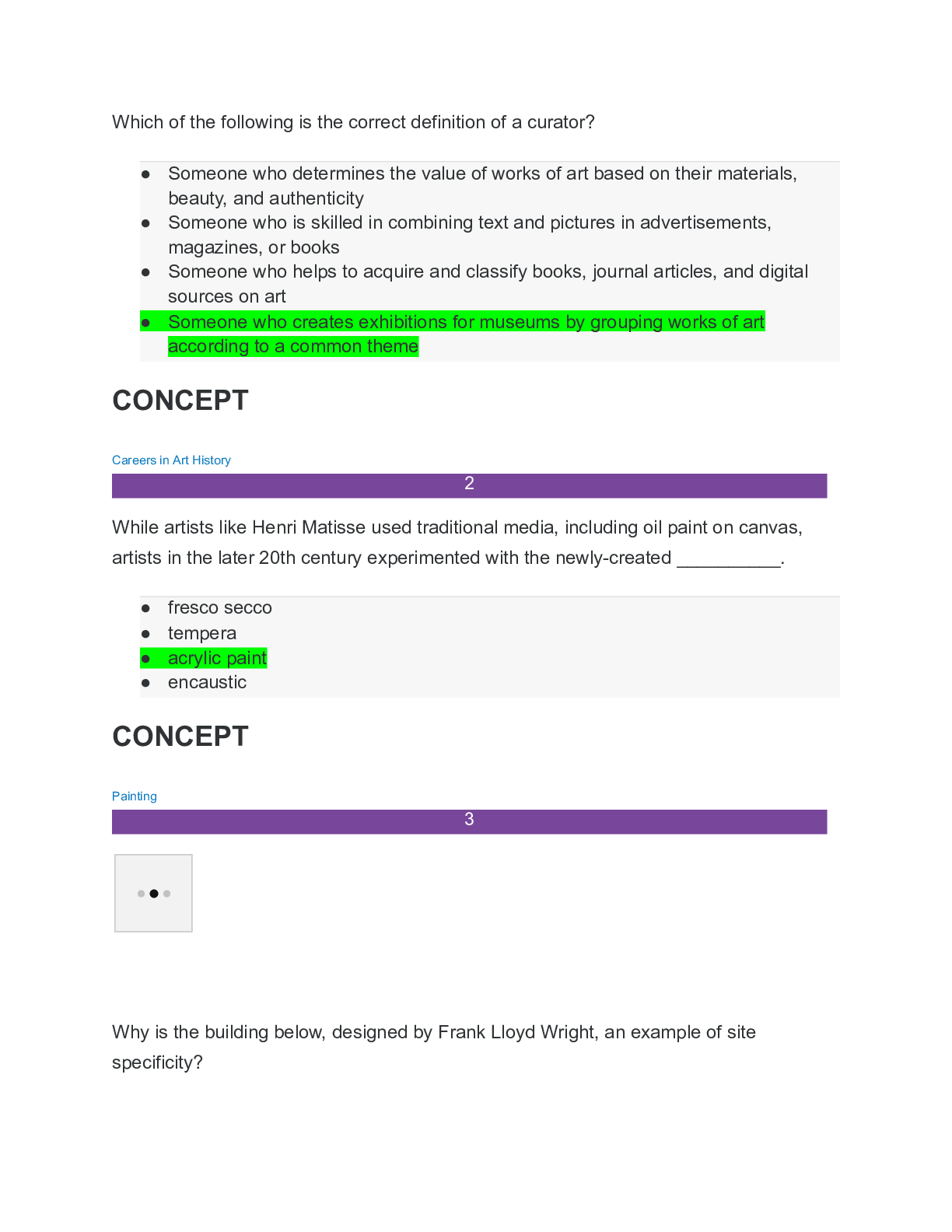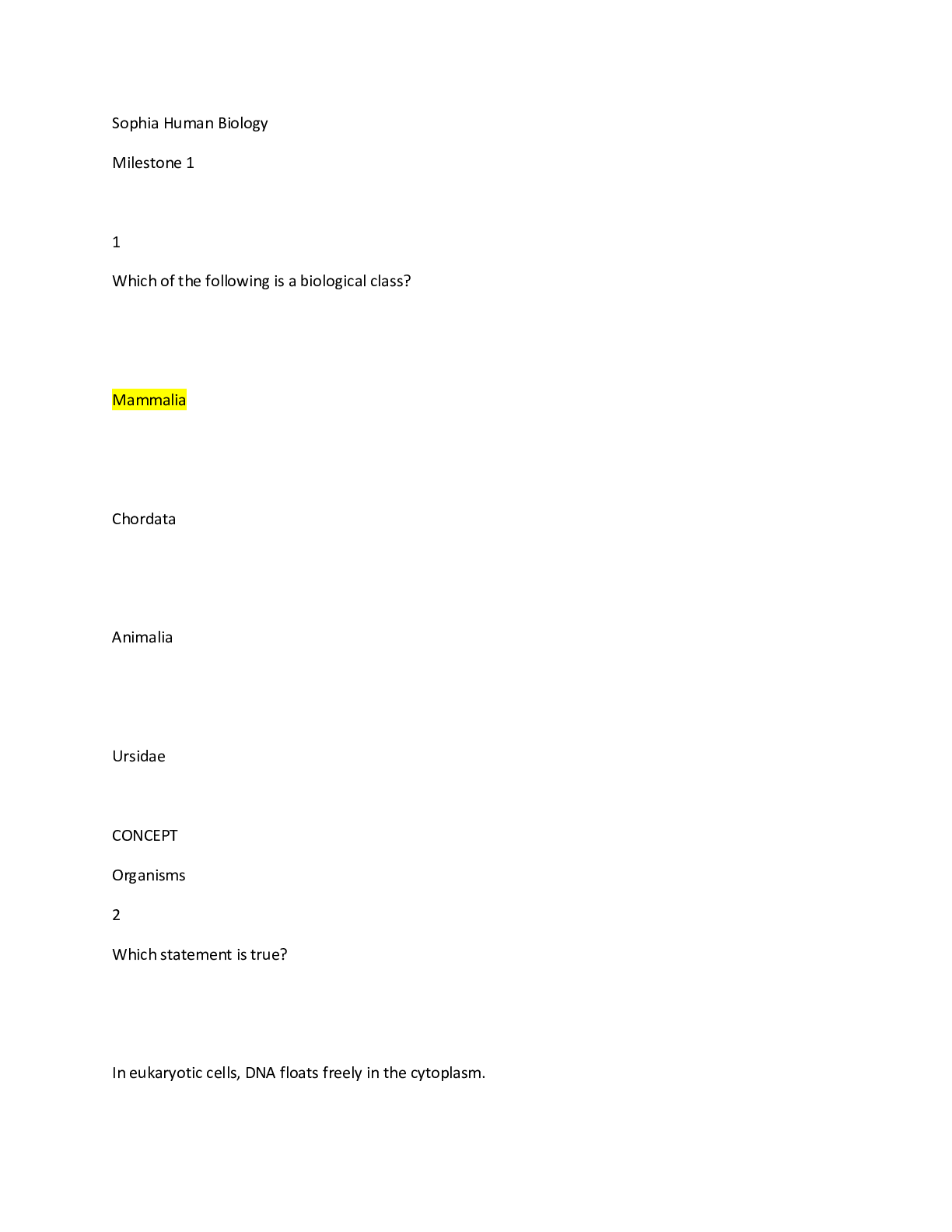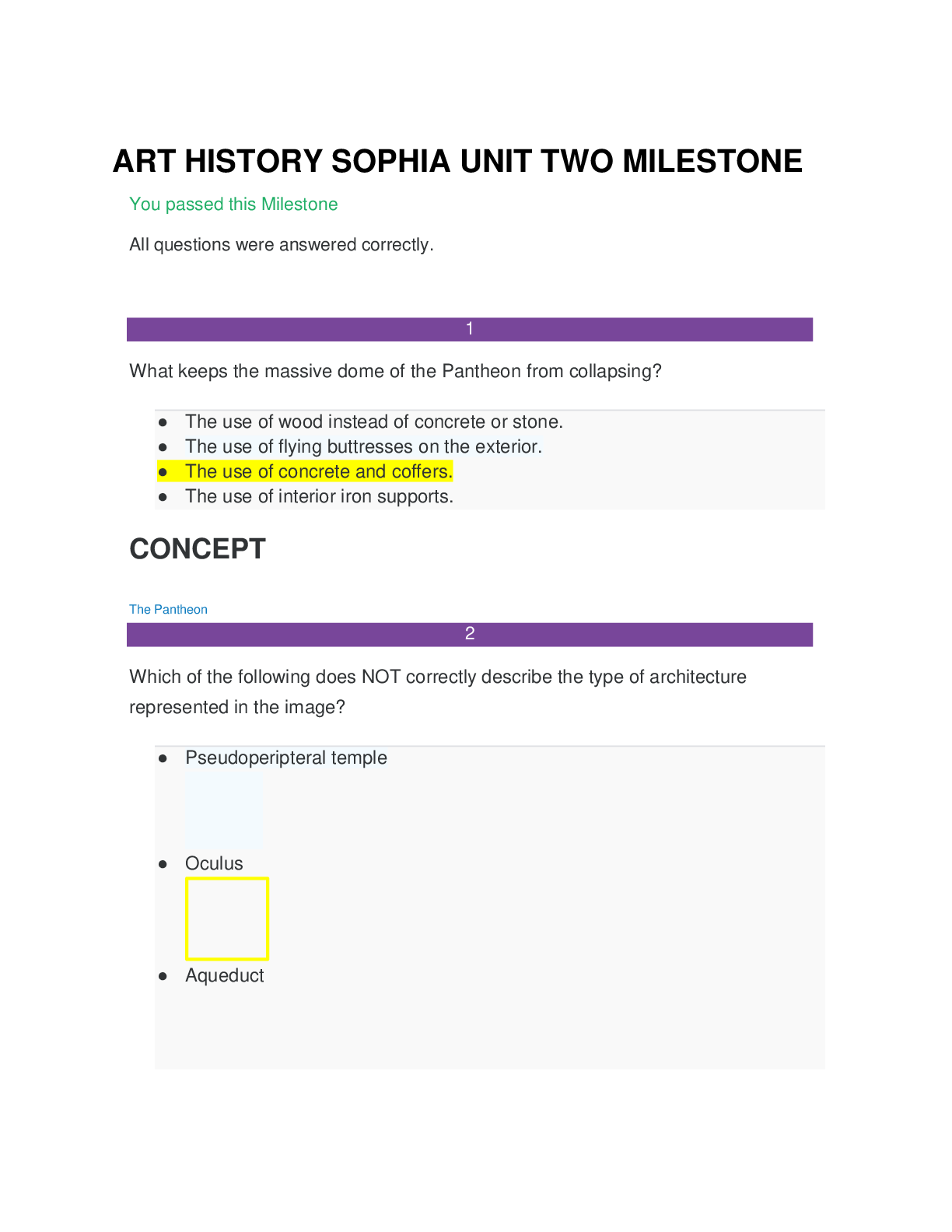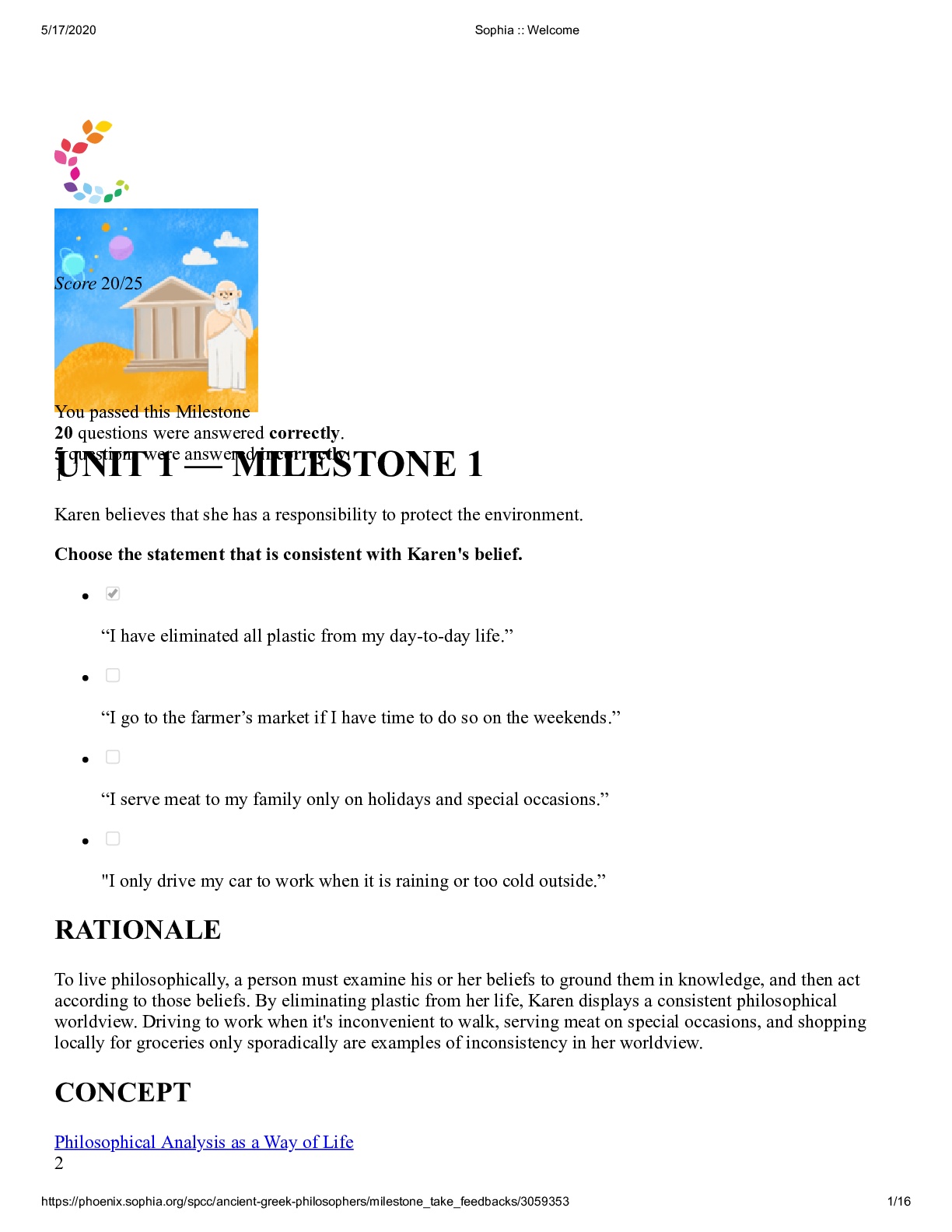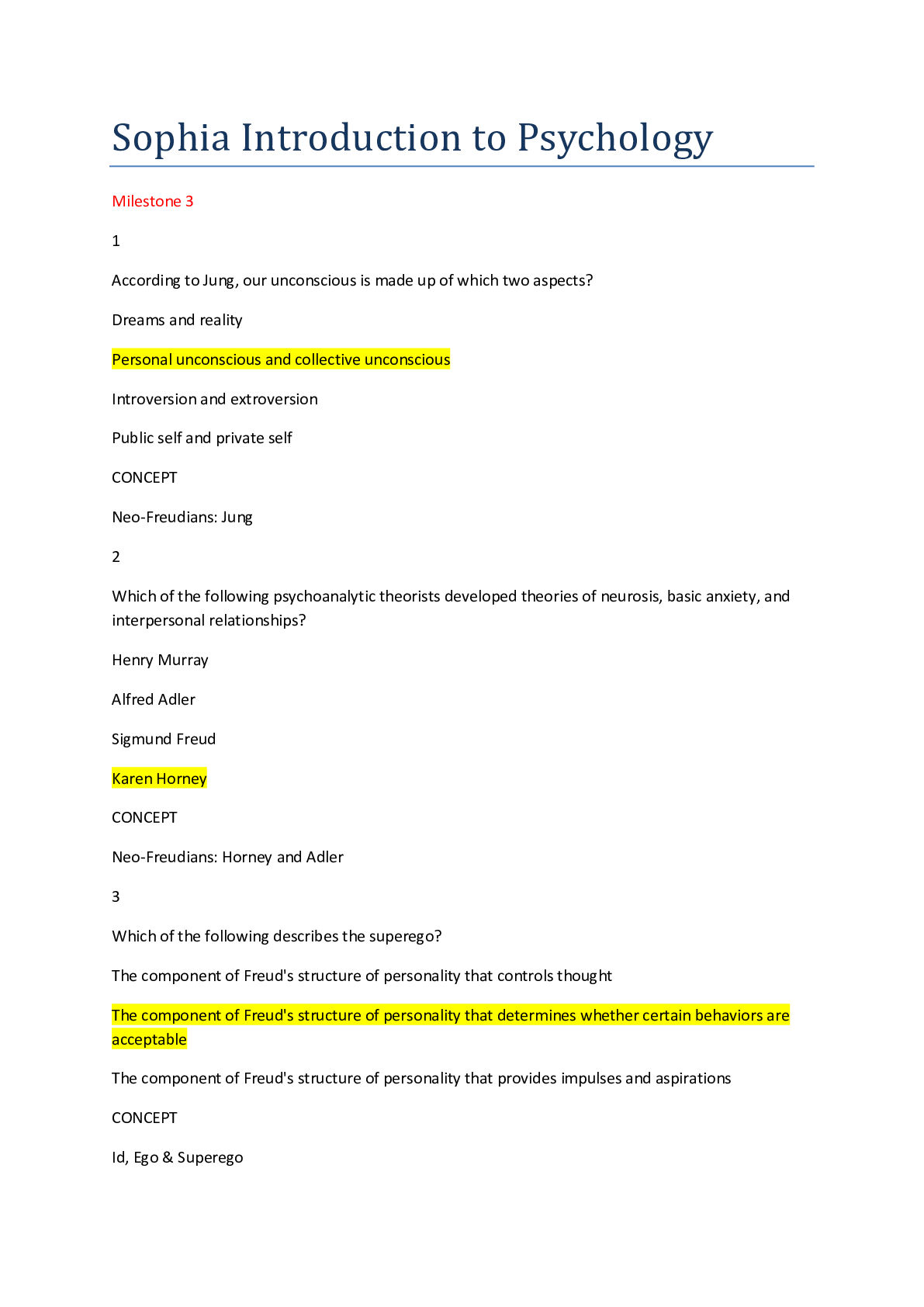History > SOPHIA Milestone > U.S History 2-Unit 2 -Milestone 2|Sophia - US History II - Milestone 2 Final (All)
U.S History 2-Unit 2 -Milestone 2|Sophia - US History II - Milestone 2 Final
Document Content and Description Below
U.S. History 2-Unit 2 -Milestone 2 U.S History 2-Unit 2 -Milestone 2 The Red Scare was in response to labor unrest and radical activism following World War I. Which event is considered a con... sequence of the Red Scare? During the 1920s, W. E. B. Du Bois and Marcus Garvey were early proponents of an ideology known as Pan-Africanism. What was a key way in which Garvey’s beliefs differed from that of Du Bois? President Roosevelt introduced a First New Deal and a Second New Deal to overcome the Great Depression. Choose the action that was associated with the Second New Deal. Select a factor that shifted American foreign policy toward imperialism in the 1890s. “Article X diminishes American independence by taking away Congress’s power to declare war.” Choose the person or group that held this belief regarding the proposed League of Nations, particularly Article X. q As World War I broke out in Europe, President Woodrow Wilson sought to maintain U.S. neutrality for which of the following reasons? Q Although many young Americans in urban areas were associated with the “new generation” during the 1920s, the decade also witnessed the rise of the Lost Generation. Which of the following describes an aspect of the “Lost Generation?” Q Which of the statements describes the relationship between U.S. participation in World War I and Progressive reform? Q What popular 1920s musical style, which had a quick rhythm and was largely improvised, was associated with the “new generation” of urban young people? Q What was one purpose of the Civil Works Administration, which was a part of Franklin Roosevelt’s First New Deal? Q Read the sentence from a Chicago newspaper account of a race riot during the Red Summer. White bathers at the Twenty-ninth street improvised beach saw a colored boy on a raft paddling into what they termed ‘white’ territory. A snarl of protest went up from the whites and soon a volley of rocks and stones were sent in his direction. Select the statement that accurately explains what is happening in this account. Q Consider the photograph titled, “One of the pioneer women of the Oklahoma Panhandle dust bowl,” taken by Arthur Rothstein in April 1936. Why does the photographer call the woman in the image a “pioneer?” Q Theodore Roosevelt’s “Square Deal” had three main components, one of which was consumer protections. What else was included in his plan? Q Why did President Theodore Roosevelt use the power of his office to advance Progressive reform? Q Which statement is true of the Progressives? Q Study the political cartoon published in Judge in 1905. Louis Dalrymple, “The World’s Constable,” Judge, January 14, 1905 Which of the following is the best example of Theodore Roosevelt’s use of “The New Diplomacy?” Q What was a cause of the Great Depression? Q This illustration entitled “Uncle Sam’s Temptation”, by cartoonist Clifford Berryman, which appeared in The Washington Post on June 26, 1898, shows Uncle Sam being served a bowl of anti-annexation broth while the English John Bull tries to persuade him otherwise and encourages the U.S. to annex its conquests in the Spanish-American war. How does this image reflect a reason for American imperialism at this time? Q Choose the statement that describes a cause of the War of 1898. Q Many historians have argued that the New Deal changed American politics and governance. Which statement supports this argument? Q Which statement is most likely to have been spoken by W.E.B. Du Bois, reflecting his approach to black equality in the Progressive Era? Q Progressives pushed for democratic reforms in party politics, which included allowing party members, rather than delegates, to nominate candidates for office. What is the term for this reform? Q Which statement reflects President Herbert Hoover’s response to the Great Depression? Q The New Deal transformed the Democratic Party. Choose one example of this transformation. Q Which of the statements reflects President Herbert Hoover’s response to the Great Depression? Q Why did President Theodore Roosevelt use the power of his office to advance Progressive reform? Q Which of the following statements best describes the Reservationists’ stance toward the Treaty of Versailles? Q Choose the true statement about Progressives or the Progressive era. Q Theodore Roosevelt’s “Square Deal” had three main components, one of which was consumer protections. What else was included in his plan? Q A neighborhood in New York City, Harlem, became a center for a black political and cultural movement in the 1920s. Which of the following statements best describes the “New Negro” movement? Q Choose the region where the United States acquired territory after the Spanish-American War of 1898. Q Which event from the 1920s is associated with the resurgence of American nativism during that decade? Q Select a factor that shifted American foreign policy toward imperialism in the 1890s. Q President Franklin Roosevelt oversaw both a First New Deal and a Second New Deal to curb the Great Depression. Choose the action that was part of his Second New Deal. Q What was one purpose of the Agricultural Adjustment Act as a part of Franklin Roosevelt’s First New Deal? Q The Red Scare was a period following World War I in which Americans suppressed radical dissent. Which event is considered a cause of the Red Scare? Q Youth in urban areas during the Roaring ’20s adopted a new morality. What was one of the features of this new morality? Q The cartoon above was printed in 1907 in the Washington Evening Star. Uncle Sam offers a baseball bat called “National Big Stick” to a player in a Nationals uniform, a reference to President Theodore Roosevelt’s big stick diplomacy. Roosevelt had recently offered the Roosevelt Corollary to the Monroe Doctrine, an example of his big stick approach, in 1904. He was also continuing work in the Panama Canal in 1906. Teddy bear, a reference to Roosevelt, assures the player that “it’s a victory getter, all right!” How does this cartoon depict the state of American foreign policy in the early 1900s? Q The New Deal transformed the Democratic Party. Choose one example of this transformation. Q Read the excerpt from the Chicago Daily Tribune that describes an event that turned into a race riot in Chicago during the Red Summer. “Racial feeling, which had been on a par with the weather during the day took fire shortly after 5 o’clock when white bathers at the Twenty-ninth street improvised beach saw a colored boy on a raft paddling into what they termed ‘white’ territory.” What do the details tell the reader about the writer’s perspective on the event? Q Study the political cartoon published in Puck in 1899: All of the following are aspects of U.S. foreign policy during the Progressive Era represented in this political cartoon EXCEPT __________. Q Men stand outside a soup kitchen in Chicago opened by Al Capone in February 1931. 60 million people, including many members of the middle class, were affected by the Great Depression by the end of 1932, and soup lines became common in urban cities. For many, the descent into poverty was a result of which of the following? Q Many historians have argued that the New Deal permanently changed the U.S. Which of the following is a long-term effect of the New Deal identified by historians? Q As cities began to adopt Progressive reforms for governance, these reforms included electing people to run specific city operations. What is the term for this reform? Q Which of the following was a cause of the Great Depression? Q Which statement is most likely to have been spoken by Booker T. Washington, reflecting his approach to black equality in the Progressive Era? Q When the United States entered World War I, suffragists saw the opportunity to enact a women’s suffrage amendment. What was one of their main reasons for optimism? Q After President Woodrow Wilson’s “peace without victory” speech, several events occurred that led to the United States entering World War I. Which of these events most contributed to the United States entering the war? [Show More]
Last updated: 8 months ago
Preview 1 out of 9 pages

Reviews( 0 )
Document information
Connected school, study & course
About the document
Uploaded On
Sep 16, 2020
Number of pages
9
Written in
Additional information
This document has been written for:
Uploaded
Sep 16, 2020
Downloads
1
Views
110

